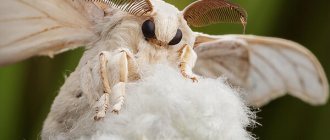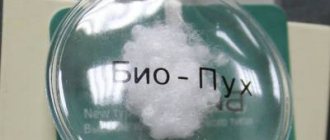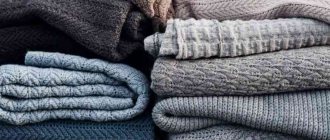Silk clothing looks extremely attractive thanks to the flowing texture of the fabric, shine and color shift. Silk items add grace and nobility to a woman's look.
Natural silk is an expensive material, and the care of clothing made from this fabric should be treated with the utmost care. Wrong choice of detergents, violation of the temperature regime, and instead of a festive outfit you will end up with a nondescript rag, or the item will shrink hopelessly.
Material properties
Silk thread is a waste product of the silkworm. Organic material changes its characteristics when wet - the thread becomes fragile. Products made from natural silk are not resistant to aggressive environments, primarily chlorine, which irreversibly damages fabric fibers and “eats” the dye.
The peculiarities of the weave of the threads, due to which the fabric has a shiny iridescent surface, complicate the care of things. Contact of water or other liquids with the material leads to the formation of stains and streaks that are difficult to remove without washing.
Silk is dried and ironed according to certain rules, violation of which leads to severe shrinkage of the fabric - the item loses its shape. Washing can only be done by hand; the delicate mode of an automatic washing machine is only suitable for items made of artificial silk.
Proper care
If you properly care for silk, your items will delight you with their attractive appearance for many years. Note:
- Natural silk has a bactericidal effect - the material does not promote the growth of germs and bacteria, so things can be washed less often than clothes made from other materials. It is important to ventilate silk clothes well.
- Table salt helps add shine to the fabric. Simply rinse the washed item in a solution, the preparation of which requires 200 grams of salt and 10 liters of warm, clean water.
- Difficult stains should not be washed separately - this will lead to unsightly stains on the item that cannot be removed without rinsing the entire item in water.
To remove the stain, use the appropriate method, choosing from the options provided. Before cleaning the product, check on an inconspicuous area of the fabric to see if the prepared composition will not damage the color and structure of the material.
- Prepare a cleaning paste from potato or corn starch with the addition of a small amount of water. Apply the paste to the stain and wait until it dries completely. Then the composition is removed using a soft brush or brush.
- Before washing the product, treat the stain with an aspirin solution - two tablets of this medicine are required for half a glass of warm water.
- Remove tea or coffee stains using a foam sponge lightly moistened with glycerin.
- Diluted ammonia will help rid silk wardrobe items of sweat stains.
In difficult cases, it is recommended not to clean or wash the silk yourself, but to take the items to the dry cleaner.
Caring for silk clothes
Products made from natural materials must be kept in a well-ventilated, dry area. You cannot put things in a closet on a shelf. It is best to hang them on hangers.
Do not allow perfumes and deodorants to come into direct contact with silk. Otherwise, this will lead not only to stains, but also to the destruction of the delicate structure of the material.
How to store
Silk products should be stored in cases made of natural materials. This is a mandatory rule for long-term storage. The use of polyethylene or synthetics will lead to the accumulation of moisture inside the cover and, as a result, to the appearance of mold and a yellow tint on the clothes.
Since silk is a natural material, it is a favorite delicacy for moths. Therefore, it is necessary to take care of protection in advance in the form of special means - aerosols, sachets, tablets.
How and what to wash
Natural silk items should only be washed by hand. The water temperature should not exceed 30° C. Pre-soaking and vigorous squeezing of the product are prohibited.
When washing, do not use products containing bleaches, solvents and other aggressive components. Only soft detergents are suitable for washing. This could be baby shampoo, baby soap, or silk detergent. You can rinse silk products in a vinegar solution. It is prepared at the rate of 15 ml of vinegar per 1 liter of water.
You can remove heavy stains yourself:
- Soak a cotton swab in denatured ethanol and wipe away any perfume stains.
- Glycerin can remove coffee and tea stains. To do this, apply a thin layer of the product to the stain and wait 25-30 minutes. After this, rinse the product thoroughly.
- Apply starch paste to blood stains. Next, the clothes are shaken well and washed.
- Fresh wine stains should be sprinkled with salt and left for 30-40 minutes. After this, the item is washed using a detergent for silk products.
- Almost any stain can be removed with a 10% vinegar solution. You can also use aspirin tablets (2 tablets per 200 g of water).
How to dry and iron
Proper care of the material is not only about proper storage and washing. The quality and appearance of silk also depends on proper drying and ironing.
Dry as follows:
- They do not wring out a clean item, but give it time for the water to drain naturally.
- Next, the product is placed in a terry towel or sheet, having previously rolled it up with a roller.
- When the outer fabric has absorbed as much moisture as possible, the product is unrolled, carefully smoothed by hand and spread on the table. First, dry material must be placed on the table surface.
- Slightly damp items can be hung on hangers. Large items can be hung on a rope. Drying should be done in a well-ventilated area. Direct sunlight must be excluded.
To prevent delicate fabric from becoming deformed, it is forbidden to dry silk items on radiators or with a hair dryer.
As a rule, if the item is dried properly, ironing can be avoided. If you still need to stroke it, then follow simple rules:
- Silk items are ironed slightly damp.
- The temperature is set within 70° C. This is the minimum level.
- Products are ironed from the inside out. Dry cloth is spread on the surface.
- Do not iron silk items if they are very wet. This will lead to deformation and an unsightly reflection.
- If things are too dry, you cannot spray them with water. Otherwise, it will lead to stains. You can simply steam them. To do this, fill the bathroom with steam from hot water and hang the product there on hangers.
Washing principles
The question of how to wash silk items worries many housewives who are afraid of ruining expensive clothes made from natural material. Let's look at how to wash natural silk, protecting the fabric from negative consequences.
Handwash
Products made from silk fabric are washed mainly by hand - in this case there is less risk of damaging the material. This also applies to products that have a machine washable symbol on the label. You can find the decoding of the designation at the link.
To wash silk, use warm water with a suitable detergent dissolved in it. You should not soak the item for a long time - a few minutes is enough. The fabric is prohibited from rubbing, brushing, squeezing, or rubbing with a bar of soap. The movements should be light, as when rinsing things.
Using an automatic machine
In a washing machine, even when programmed on a delicate cycle, the material is subjected to mechanical stress. This can destroy the structure of the fabric, since its fibers become brittle when wet.
If you nevertheless decide to wash a silk blanket or wardrobe items in a machine, since there is a corresponding sign on the labels, you should select the “Silk” mode, and in its absence, “Hand Wash”.
Due to the use of an increased volume of water in these modes, laundry detergents are better washed out of the fabric, and unsightly stains will not appear after drying. The drum rotation speed is also reduced, which reduces the risk of mechanical damage to the fabric. It is recommended to use the “Drain water” option to avoid spinning the product. In extreme cases, spinning at low speeds is allowed.
If you are unsure whether a particular silk item can be machine washed, it is better to play it safe and wash it by hand. It is allowed to place products that are similar in color into the drum of the automatic machine to avoid the appearance of faded spots. To protect silk clothes or linen from deformation, wash items in a special net.
Washing silk by hand
Natural silk will retain its attractive appearance for a long time if it is cared for in strict accordance with the rules. The entire list of recommendations can be established by looking at the label sewn to the clothing, but it is not always recommended to rely on it. To figure out how to wash silk, you need to follow certain rules.
- It is best to use prepared water: you will need chilled boiled water, the maximum temperature of which will be +40 degrees.
- As mentioned earlier, the use of aggressive detergents, especially those containing chlorine (this includes various types of stain removers and bleaches), is strictly prohibited. It is best to wash silk items in a solution of colorless toilet soap, hair shampoo, or the softest powder intended for hand washing only. The product used should be completely dissolved in water so that not the slightest sediment remains.
- The washing process itself involves placing items in the resulting solution. They are left there for approximately 15 minutes. After such soaking, the items are washed as carefully as possible, avoiding too much impact on the fabric, as it may simply tear. In particular, do not wash, stretch or twist clothing. You just need to fully understand once exactly how silk items are washed, after which similar questions simply will not arise.
- You also need to know how to rinse a silk item correctly. The silk item is washed in water several times to remove all traces of detergent, while at the same time the temperature of the water decreases. During the last rinse, pour a small amount of table vinegar into the water. This moment allows you to preserve the original color of the product.
- Push-ups are performed as follows. In the case of silk items, there will be no usual push-ups. The product is very carefully removed from the water, wrapped in a soft towel and gently wrung out.
In this case, the washing process is completed, but there are still several important points related to the care of silk items. In particular, when caring for them, they have their own drying and ironing technology.
Selecting detergents
When figuring out how to wash natural silk, pay special attention to the choice of detergents. Allowed to use:
- special products for delicate washing with a mild action, preferably liquid or in gel form;
- clear toilet soap, baby soap;
- shampoo without coloring effect.
It is prohibited to use:
- bleaches, primarily chlorine-based;
- washing powders with biologically active additives - they break down protein, and natural silk is a protein substance;
- laundry soap - high alkali content harms natural fiber.
How to wash silk items
Usually silk is washed in water at a temperature not exceeding 30 degrees. Fill a basin with lukewarm water and add liquid delicate detergent. Stir the product thoroughly, as if the concentrate gets on the fabric, it may be damaged. If your silk items are colored, then when choosing a liquid powder, look for packaging marked “Color”.
Remember that silk items should never be bleached. Silk fibers are protein compounds, so the effect of bleach on them is accompanied by the destruction of bonds and, accordingly, the fabric is torn. It is also not recommended to soak silk items, but if you cannot do without it, then immerse the item in water for only ten minutes.
Water parameters
It is important to know at what temperature natural silk is washed. The water used is slightly warm, approximately human body temperature. It is better to limit the heating in the machine to 30 degrees.
Be sure to keep an eye on the softness of the water. If it contains a lot of dissolved salts:
- when machine washing, add softener tablets;
- When washing by hand, use boiled water or add 10 grams of soda or ammonia to a container with 10 liters of water.











